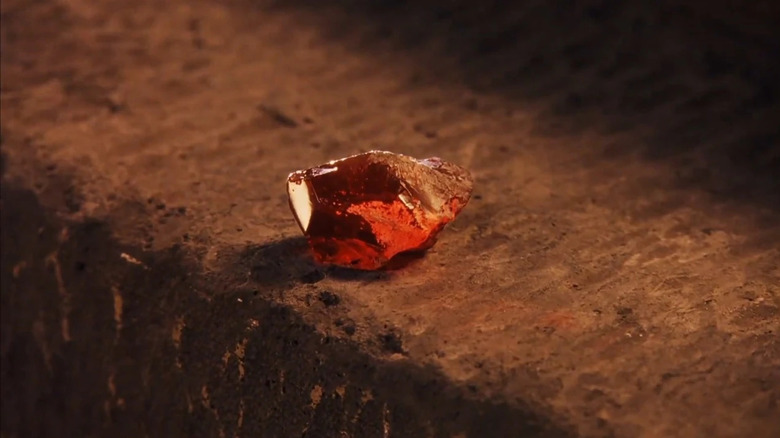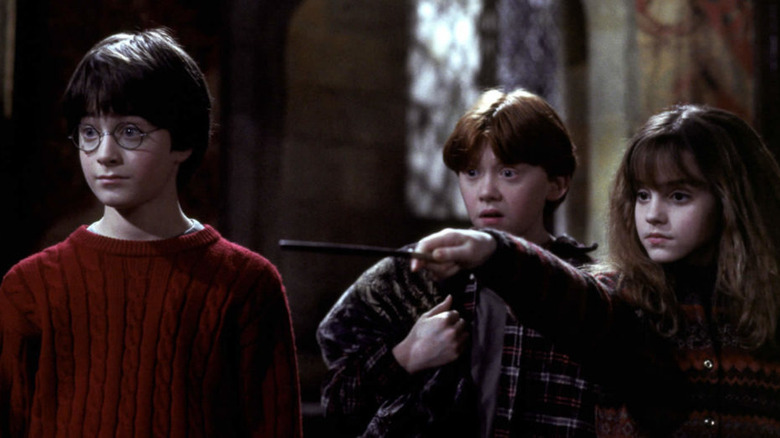Harry Potter Filmed Two Different Versions Of A Key Scene For UK & US Audiences

Did you know that part of the first movie in the “Harry Potter” film franchise (“Harry Potter and the Sorcerer’s Stone,” as it’s known in the U.S.) is different depending on which country you live in? If you didn’t, you’re not alone — “Harry Potter” fans are shocked that they never noticed.
As People Magazine reported, a fan account on Instagram — which, it should be said, bears the pretty official-looking title @harrypotter — posted a clip from the first “Harry Potter” film showing Hermione Granger (Emma Watson), Ron Weasley (Rupert Grint), and Harry Potter (Daniel Radcliffe) discussing the mysterious object lurking underneath a guarded trap door at Hogwarts School of Witchcraft and Wizardry. In the version released in the United Kingdom, Hermione calls it the “Philosopher’s Stone,” but in the American one, she calls it the “Sorcerer’s Stone.”
Anyone familiar with the books written by the property’s transphobic creator Joanne Kathleen Rowling knows that their titles also differ from country to country, and American audiences were the only ones who got “sorcerer” instead of “philosopher.” People notes that in the United States, a philosopher simply studies philosophy, so “sorcerer” felt more appropriate; the outlet also quotes an interview from Rowling about the change. “Arthur Levine, my American editor, and I decided that words should be altered only where we felt they would be incomprehensible, even in context, to an American reader,” Rowling is reported to have told Borders Online in 1999 (via the HP Lexicon).
So what does this stone with two names actually do in the Harry Potter universe?
No matter what this magical little stone is called, what does it do — and why is it special enough to title the first installment in the “Harry Potter” franchise? Based on a “real” mythical stone that was highly sought after during the Middle Ages, “Harry Potter’s” take on the Philosopher/Sorcerer’s Stone is that it was created by a man named Nicholas Flamel, a wizard and alchemist who used the stone to craft the Elixir of Life and stay alive for several centuries. (It can also, incidentally, turn any metal to gold, so along with that everlasting life, you can get really, really rich.)
The reason this little rock is so important in the first “Harry Potter” book and movie centers around the fact that Harry’s nemesis, the Dark Lord Voldemort, is trying to stage a comeback … and as he uses Hogwarts professor Quirinus Quirrell as a host for the remaining fragments of his soul that survived after he tried to kill baby Harry and faced his own Killing Curse as it rebounded. Albus Dumbledore (Richard Harris) knows this, and as a result, he hides the Stone deep in the bowels of Hogwarts to try and protect it, complete with massive magical tasks set by several professors in the school. (The fact that three 11 year olds are able to pass these magical tasks with relative ease doesn’t speak super highly of Dumbledore’s plan, though.) Harry ends up finding the stone using the Mirror of Erised, which Dumbledore enchanted to give the stone to someone who wanted to have it but not use it for selfish gain, and in doing so, he keeps Voldemort from returning to his full strength.
Will this small yet significant change be a part of the Harry Potter reboot series?
Now that a “Harry Potter” reboot series is officially coming to Max — HBO’s proprietary streaming service with a silly name — will the creative team behind the series implement this same change for the first installment (presumably the first season)? We don’t know a whole lot about the series, but we do know that it’ll be helmed by veteran “Succession” and “Game of Thrones” director Mark Mylod, who will direct episodes and executive produce the show under the watchful eyes of fellow “Succession” alum Francesca Gardiner (who will serve as the showrunner).
I would think that, after decades, any new “Harry Potter” installment would assume that American audiences know that a “Philosopher’s Stone” doesn’t refer to a normal rock owned by someone who happens to read a lot of Rene Descartes, but who knows? It’s still completely possible that the series will go out of its way so as not to confuse people who live in the United States. Stranger things have happened. In any case, you can watch the American version of this scene on Peacock now.
Source link






